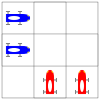
The Hero Twins, Born of Water and Monster Slayer, are the twin sons of Changing Woman and were born to rid the earth of the monsters who were killing the Diné, or the Navajo people. Monster Slayer is the elder twin, known as Nayénzgan in Diné, and Born of Water is the younger twin, known as Tobadzîschíni in Diné.
They begin by visiting their father the Sun and, after passing through many trials, are given weapons. The younger twin, Born of Water, is given prayer sticks and told to watch them as the older twin Monster Slayer goes out to fight the monsters. If the prayer sticks begin to burn, he will know that Monster Slayer is in danger and needs help. Monster Slayer goes alone to kill some of the monsters and Born of Water accompanies him while killing others.
Sometimes Monster Slayer is referred to as The Hero Twin (singular), probably because he does most of the fighting. However, because of their perseverance, both twins become warriors and so serve as a model for young Navajo men today.










